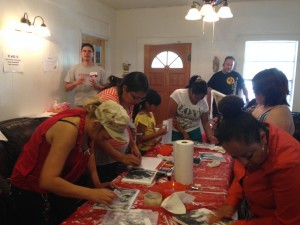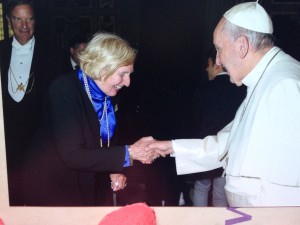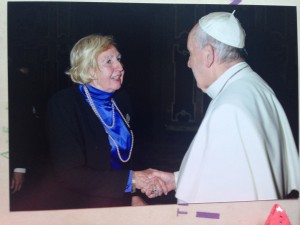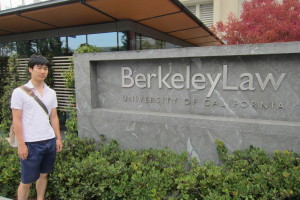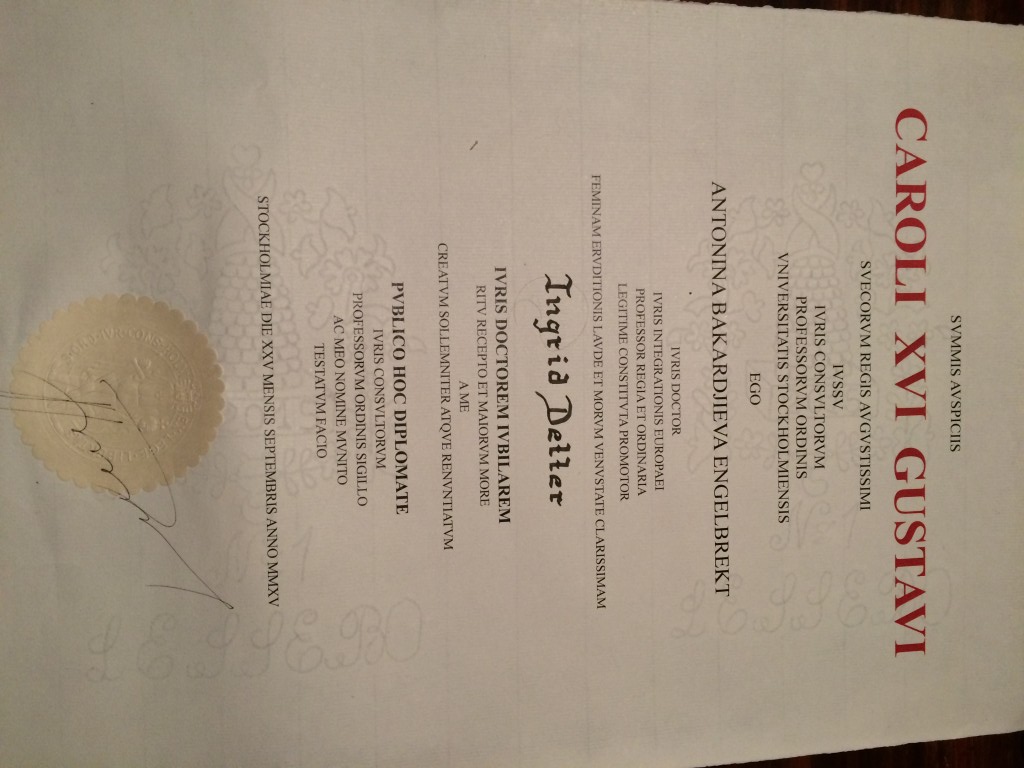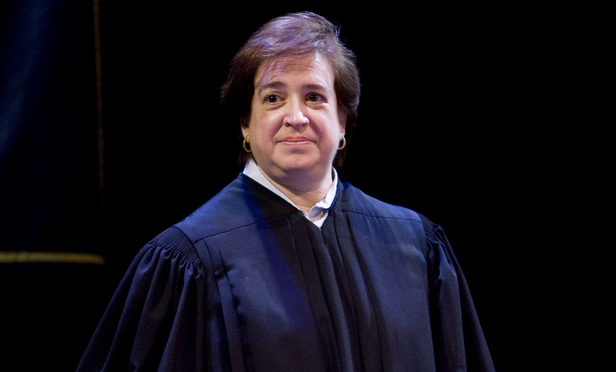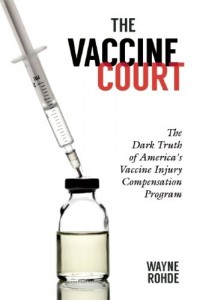RJ GAUDET & ASSOCIATES L.L.C.
"Let us realize the arc of the moral universe is long but it bends toward justice."
Dr. Martin Luther King, Jr.
Archive for the ‘Uncategorized’ Category
Where Lawyering Meets Morality: Advising the Vatican on Environmental Legal Issues
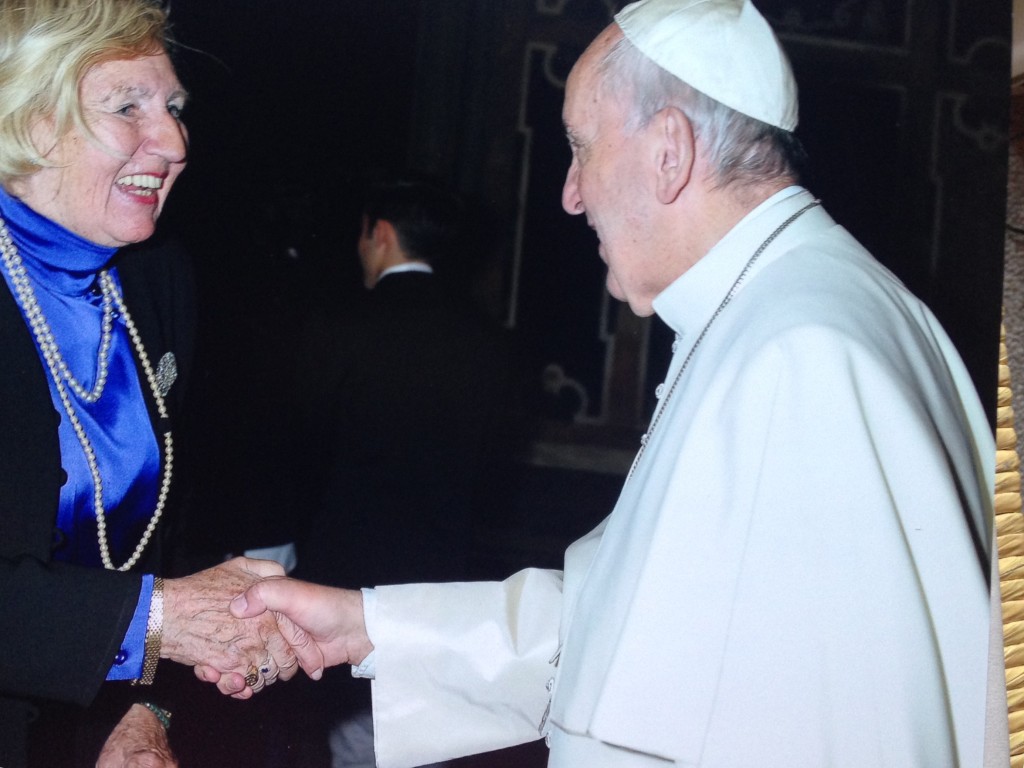
Prof. Dr. Detter de Frankopan Meeting Pope Francis at the Vatican Prior to Speaking With Polish Coal Miners About the Legal Consequences of the Pope’s Encyclical on the Environment
The Vatican recently called upon Prof. Dr. Detter de Frankopan for advice on the international legal impact of the encyclical, Laudato Si, which discusses the environment. Prof. Dr. Detter de Frankopan and Cardinal Peter Turkson had a private audience with Pope Francis.
Related to Prof. Dr. Detter de Frankopan’s legal advice, Pope Francis released Laudato Si, which is available here, on May 24, 2015. The full name of the document is “Encyclical Letter, Laudato Si, of the Holy Father Francis On Care For Our Common Home.”
The Encyclical likens earth to a sister and “mother” who “cries out to us because of the harm we have inflicted.” It asks people to protect bio-diverse systems in the Amazon, Congo, and elsewhere from “huge global economic interests which, under the guise of protecting them, can undermine the sovereignty of individual nations.” The Encyclical warns of transnational corporations with self-interested proposals to internationalize the Amazon as well as popular consumerism and the spread of a “throwaway culture,” a term the Pope has used in speeches. The Encyclical was inspired by St. Francis of Assisi who loved flowers and animals and spoke to the Earth, Sun, and Moon as his friends.
Pope Francis advocates for the abandonment of fossil fuels and their replacement with renewable energy. Although he is not a Catholic, Pres. Obama appears to agree with this general direction as he recently declined to establish a Keystone pipeline and, instead, said we should keep our fossil fuels in the ground.
The Pope’s Encyclical is not without controversy. For instance, Catholic miners in Poland are concerned that they may lose their jobs as the result of the legal implementation of the Encyclical.
As a result, Prof. Dr. Detter accompanied Cardinal Peter Turkson to Poznan, Poland to explain to the miners that legal implementation would only occur very gradually. In addition to speaking with Polish miners, Prof. Dr. Detter de Frankopan and Cardinal Turkson attended an environmental conference, Pol-Eco System Conference.
The Pol-Eco System Conference: International Trade Fair of Technologies and Products For Sustainable Development and Municipal Services took place in Poznan, Poland from October 11 – 14, 2015. The conference featured special exhibitions on renewable energy, water management, environmental protection, and other matters. More information about the conference is available at this link.
The Encyclical reflects a belief in the common brotherhood of people and, even, in the unity of all earthly creatures: “Because all creatures are connected, each must be cherished with love and respect, for all of us as living creatures are dependent on one another.” This is reminiscent of Dr. Martin Luther King, Jr.’s assertion that we are all interconnected within a single web.
What is the role for lawyers? Prof. Dr. Detter de Frankopan advises the Vatican on international law and explains the legal ramifications of moral beliefs. Another example is New York lawyer Jenik Radon who advises sovereign nations on the risks in contractual agreements with the oil, gas, and mineral industry. Mr. Gaudet and Mr. Radon currently advise a small landowner in Louisiana regarding negotiations with an oil and gas company that wishes to engage in fracking.
Lawyers have a role to play in writing normative values into legal contracts to ensure that the environment is not wasted or destroyed. They can give voice to weaker and less experienced parties, such as individual landowners or even small sovereign nations, in negotiations with multi-national oil and gas companies.
ABOUT RJ GAUDET & ASSOCIATES LLC: the firm is registered in Seattle with office addresses in El Paso, Berkeley, and The Hague. It consists of lawyers who are licensed in Texas, Washington, New Jersey, and the United Kingdom and who work across the United States with local counsel on litigation, class actions, international human rights, international law, wage and hour matters, environmental issues, and other types of cases. Prof. Dr. Detter de Frankopan is Of Counsel.
Japan Enables Small Toehold, In Late 2016, For Class Actions By Consumer Associations
By Robert J. Gaudet, Jr.
In what is likely to yield a trickle rather than a tsunami of justice, Japan will allow class action-type lawsuits filed by consumer associations to seek damages in a new law that will take effect in December 2016.
On Sunday, October 24 at a Halloween barbeque of the Berkeley LLM students, I met a student from Japan, Shoichi Hara, who is on temporary leave from his position as a judge in Japan. We spoke about class actions. Judge Hara subsequently explained to me, by email, the status of Japanese class actions:
“In Japan, the Consumer Court Special Procedure Act (a Japanese-version of the class action) was promulgated on December 11,2013 and will be enforced within 3 years from that day, taking effect in December 2016. Since it has not been enforced yet, there are no cases now. The Act will allow only qualified consumer organizations to sue against business operators instead of allowing each consumer to file a lawsuit. There will be two steps in the procedure. In the first step, a court will decide the presence of legal liability. After declaring the legal duty of defendant in the first step, the court will inform relevant consumers of the procedure and decide each person’s amount of damage in a simple procedure.
Before the Consumer Court Special Procedure Act, Japan previously introduced another Special Act which enabled qualified consumer associations to file a lawsuit for injunction instead of consumers. The average number of cases per year (from 2009) is about 15, which is increasing, but there have not been so many yet. So, Japanese class action or other consumer protection systems have only just started.”
The Consumer Court Special Procedure Act will bring a slight advantage over the status quo. Presently, there are only a few procedural devices available: (1) joinder which, as in the United States, allows numerous individuals to file their own lawsuits and have them consolidated into a single action, (2) representative actions in which representatives can be appointed, upon explicit instructions from each one of the victims, to represent others with “common interests”; and (3) lawsuits for injunctive relief only filed by “certified” consumer associations that are pre-approved by the Prime Minister.[1]
With the new procedure, consumer associations will be able to file actions seeking damages. This is a slight improvement under the older law that only allowed consumer associations to seek injunctive relief. However, given the limited resources of consumer associations, it is not likely there will be a significant number of cases filed under the Consumer Court Special Procedure Act. If, as Judge Soichi reports, only 15 lawsuits for injunctive relief were filed by consumer associations under the older law that took effect in 2007, then similar numbers might be expected under the Consumer Court Special Procedure Act permitting them to seek damages.
There is a hint of paternalism in Japan’s approach. It will allow only consumer associations – not victims themselves – to prosecute lawsuits. And, under the older 2007 law, the Prime Minster has to pre-approve eligible consumer associations and may decertify any class action,[2] giving the Prime Minister the opportunity to exercise political influence over the prosecution of a case for injunctive relief.
Why don’t Japanese legislators trust victims and their lawyers to file suit as is done in the United States? As I mentioned at a conference in Brussels in 2012, Japanese legislators seem to have a paternalistic belief that victims and their lawyers cannot be trusted and that only a quasi-government association should be entrusted with the sacred duty of prosecution. There is no reason to believe a consumer association can prosecute suits more effectively or efficiently than the private bar. Nor am I aware of any empirical evidence to support the paternalistic approach.
The suits that Japanese consumer associations are allowed to file under the 2007 law are limited in scope to unjust contractual clauses and inappropriate solicitations.[3] In addition, the consumer associations must pre-notify the offender to give it a chance to fix the problem before the associations can file suit. It seems likely that similar restrictions may be placed on consumer associations seeking damages under the new law that becomes effective in December 2015.
In its own discussion over collective redress, various governments and actors who submitted comments to the European Union, also, expressed a preference for cases filed by consumer associations rather than private individuals. Therefore, it is not surprising that Japan drew from this European experience, including an irrational paternalism, in drafting its own legislation.[4]
From December 2016, it will be interesting to see how actively the consumer associations do – or do not – use their new powers to seek damages for consumers. Even more interesting, I am curious to see when Japanese legislators become willing to look beyond the paternalistic approach, gather empirical evidence, and brush aside mistrust of American-style class actions to devise a system that could, some day, invigorate the Japanese economy with a true tsunami of justice. But that day will have to wait for perhaps another decade or a subsequent generation.
[1] Sugawara, Ikuo, “The current situation of class action in Japan,” (undated), available at http://globalclassactions.stanford.edu/content/current-situation-class-action-japan (last viewed on Oct. 28, 2015).
[2] Id. at 12, 14.
[3] Id. at 11.
[4] Id. at 16 (“As a result, injunctive relief under the above mentioned consumer group actions was introduced by referring to the systems of the EU countries”).
Stockholm University Confers Jubilee Doctor Award on Prof. Dr. Detter
On September 25, 2015, Stockholm University in Sweden conferred the honor of “Doctor Jubilaris” upon Prof. Dr. Ingrid Detter who graduated from the faculty of law and went on to a D.Phil. at Oxford University and a second doctorate from Stockholm University; became the first female Fellow of St. Antony’s College at Oxford University; was elected to the Chair of International Law at Stockholm University; and served as Legal Advisor on International Affairs to the Pope, Saint John Paul II, for 25 years.
Prof. Dr. Detter attended the ceremony in Stockholm at the Blue Hall in the Stockholm City Hall, followed by a gala supper at the Golden Hall which is often called the “Little Noble Feast” since it occurs on the same premises as the annual Nobel Prize ceremony.
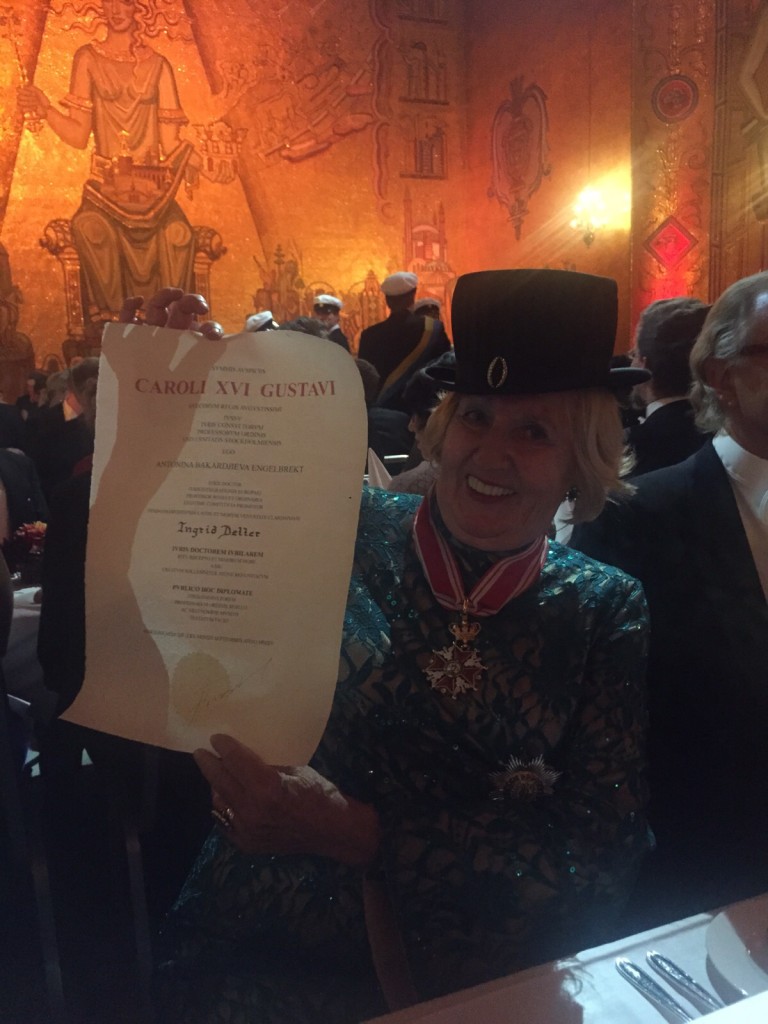
Prof. Dr. Ingrid Detter at the Gala Dinner With a Golden Mosaic Wall in the Background in the Golden Hall
The ceremony was conducted in Latin. Prof. Engelbrekt of Stockholm said, in Latin, that she had consulted with her colleagues in the law faculty and that they had selected Prof. Dr. Detter for this honor. In Latin, Prof. Engelbrekt said at the ceremony, “I order you to step forward to receive the sign of your honor.” And, then, she said, “I greet you, Jubilee Doctor” (again, in Latin) and “Good bye, distinguished Doctor” (in Latin as “Vale, clarissima, Doctor”). The program was performed in Latin to maintain the historical roots of this medieval tradition. Participants wore white tie and long evening dresses.
Prof. Dr. Detter de Lupis Frankopan was delighted to receive this honor bestowed by her colleagues on the law faculty. The Doctor Jubilaris is conferred under the auspices of King Carl XVI Gustaf of Sweden who officially serves as the head of the University. The firm of RJ Gaudet & Associates LLC congratulates Prof. Dr. Detter for this recognition.
After receiving this award, Prof. Dr. Detter has embarked to Rome for a meeting with HH Pope Francis. She advised his predecessors on matters of international law. It was, perhaps, due to her impressive scholarship and work that Prof. Dr. Detter was recognized on September 25 by her peers. Her academic career started at Oxford University where she attained a D.Phil. under the supervision of Sir Humphrey Waldock who later served as President of the International Court of Justice.
Will Class Actions Get the Hammer Next Term? The high court will take up cases further defining the rights of consumers suing corporations.
By Arthur H. Bryant*
Two years ago, dissenting in American Express v. Italian Colors Restaurant, Justice Elena Kagan, referring to the civil procedure rule on class actions, wrote, “To a hammer, everything looks like a nail. And to a court bent on diminishing the usefulness of Rule 23, everything looks like a class action, ready to be dismantled.” The message to people and companies involved in class actions was clear: “Be afraid. Be very afraid.”
Last term, the U.S. Supreme Court basically left class actions alone. This upcoming term, however, the court has already agreed to hear four cases that could dramatically restrict or terminate class action litigation in numerous ways. The concern is real. Will the court keep hammering class actions or let them be?
To understand why so many are worried, just look at the decisions that prompted Kagan’s remarks. In 2011, AT&T Mobility v. Concepcion effectively held that the Federal Arbitration Act gave corporations the power to violate state laws and use mandatory arbitration clauses in their form contracts to bar customers and workers from bringing class actions against them.
Wal-Mart Stores v. Dukes announced several new rules making it harder to prosecute cases as class actions and precluded the courts from determining whether the country’s largest private employer was discriminating against its female workers nationwide.
In 2013, neither Comcast v. Behrend, an antitrust case, nor Genesis Healthcare v. Symczyk, a Fair Labor Standards Act case, presented the questions the court heard them to address. But, instead of dismissing them, the court stopped both from proceeding as class actions on grounds not addressed by the parties.
Finally, in American Express, the court held corporations could use mandatory arbitration clauses to ban class actions when, as a practical matter, that prevented their customers from vindicating their substantive rights and let the companies illegally obtain billions.
FOUR NEW CHALLENGES
Against this background, the court’s decision to hear four new challenges to class actions has understandably raised grave concerns. Tyson Foods v. Bouaphakeo, attacking a $5.8 million jury verdict against the company for underpaying its workers, raises two questions: first, whether the trial judge should have permitted Tyson’s workers to rely on statistical sampling to establish liability and damages; and second, whether a class can be certified that contains some members who have not been injured and have no legal right to damages.
But statistical sampling has been used to establish liability and damages in cases for years. And classes have always been certified even though they contain some members who have not been injured and are not entitled to damages. For example, even if an employer is discriminating against women in hiring, unqualified female job applicants would not have been injured or be entitled to damages. That fact has never stopped class actions charging gender discrimination in hiring from proceeding.
In Spokeo v. Robins, a Fair Credit Reporting Act case, the company, charged with publishing inaccurate information and failing to provide legally required notices, contends that Congress cannot constitutionally give people the right to seek statutory damages, individually or collectively, when corporations violate the law.
Based on this rationale, it urges the court to bar class actions for statutory damages authorized by Congress to enforce the Truth in Lending Act, Fair Debt Collection Practices Act, Telephone Consumer Protection Act, Employee Retirement Income Security Act, Real Estate Settlement Procedures Act, Lanham Act, Fair Housing Act, Americans With Disabilities Act, Video Privacy Protection Act, Electronic Communications Privacy Act, Stored Communications Act, Cable Communications Privacy Act, Migrant and Seasonal Agricultural Worker Protection Act, Expedited Funds Availability Act, Homeowners Protection Act, Equal Credit Opportunity Act and the Driver’s Privacy Protection Act.
Campbell-Ewald v. Gomez presents the question the court granted review of Genesis Healthcare to decide: whether defendants can stop class actions and render them moot by offering the individual class representatives their full damages and the class members nothing. Since Genesis Healthcare, the lower courts have unanimously agreed that Kagan’s dissent in that case was right: the answer is no. But the court took the case anyway.
And, in DirecTV v. Imburgia, which charges early-cancellation penalties imposed on consumers were illegal, the company’s 2007 customer agreement said its mandatory arbitration clause was invalid if the clause’s class action ban violated “the law of your state.” It did. AT&T Mobility later held federal law pre-empted that state law, but the lower court found that didn’t matter — because the parties’ agreement was to follow state law. Contract interpretation is supposed to be governed by state law, which the Supreme Court does not create. The court could, however, still find a way to enforce the class action ban.
These cases are important to everyone in America. While they involve class actions — a procedural device — what’s at stake are the substantive and constitutional rights class actions are designed to preserve and enforce. When corporations or the government harm many people or businesses, class actions are often the only way that justice can be done.
The court will be deciding whether class actions can continue to be used, as they have been, to enforce state and federal consumer protection, employment, civil rights, civil liberties, environmental and other laws — and the state and U.S. constitutions. If it keeps hammering nails in class actions’ coffin, it could be burying significant portions of these laws as well. We will see.
*Arthur H. Bryant is the chairman of Public Justice, a national public interest law firm dedicated to advancing and preserving access to justice for all. His practice focuses on consumers’ rights, workers’ rights, civil rights, environmental protection, and corporate and government accountability.
[Reprinted from the National Law Journal (Sept. 7, 2015) with permission of Arthur Bryant, chairman of Public Justice. Mr. Gaudet is a member of Public Justice.]
Second Circuit: Class of Argentine Bondholders Cannot Include Owners of Beneficial Interests At Any Time, Too Broad
By Robert J. Gaudet, Jr.
Today, in a decision that is sure to delight the Argentine critics of Judge Griesa (and Argentina’s lawyers, one of whom has already said he is “very pleased”), a panel of three judges of the U.S. Court of Appeals for the Second Circuit reversed an August 29, 2014 order by Judge Griesa to expand the class definition of bondholders in Brecher v. Argentina, one of numerous class actions against Argentina.
On August 29, 2014, Judge Griesa had expanded the class, at the plaintiffs’ request, to include “all holders of Republic of Argentina European Medium Term Note Bond, with a coupon rate of 9.25% and a maturity date of July 20, 2004 (ISIN XS011 3833510)” without limitation as to time held. The Second Circuit held that this definition was too broad and violated the requirement that the class be “ascertainable.”
Today, the Second Circuit gave a puzzling hypothetical that, in its opinion, demonstrated that the new class definition was not ascertainable:
A hypothetical illustrates this problem. Two bondholders—A and B—each
hold beneficial interests in $50,000 of bonds. A opts out of the class, while B opts
in. Both A and B then sell their interests on the secondary market to a third
party, C. C now holds a beneficial interest in $100,000 of bonds, half inside the
class and half outside the class. If C then sells a beneficial interest in $25,000 of
bonds to a fourth party, D, neither the purchaser nor the court can ascertain
whether D’s beneficial interest falls inside or outside of the class.3 Even if there
were a method by which the beneficial interests could be traced, determining
class membership would require the kind of individualized mini‐hearings that
run contrary to the principle of ascertainability. See Charron, 269 F.R.D. at 229;
Bakalar, 237 F.R.D. at 64–66. The features of the bonds in this case thus make the
modified class insufficiently definite as a matter of law. Although the class as
originally defined by the District Court may have presented difficult questions of
calculating damages, it did not suffer from a lack of ascertainability. The District
Court erred in attempting to address those questions by introducing an
ascertainability defect into the class definition.
This hypothetical makes little sense. For instance, it assumes that it is possible that “A opts out of the class, while B opts in.” However, this is not even possible in a Rule 23(b)(3) class action, as Brecher v. Argentina was certified under Rule 23(b)(3). In such a case, bondholders are automatically members of an opt-out class unless they exclude themselves by opting out. There is no requirement or procedure by which any party “opts in.” The opt in procedure is a part of opt-in class actions brought under the Fair Labor Standards Act (and it is also a primary feature of class actions in many European countries, like Sweden and Italy, where the mechanism is rarely used) but it is not a part of a Rule 23(b)(3) class action. The Court’s hypothetical suggests a fundamental misunderstanding of the way a Rule 23(b)(3) class action functions even though the panel’s opinion may be correct in other respects.
The problem identified by the Second Circuit could be cured. For instance, the class definition could be adjusted to include owners of beneficial interests at a certain point in time, e.g., at the time of final judgment or settlement. Even this would be an improvement over the initial class definition that required bondholders to continuously hold their bonds from the date of class certification until the date of final judgment in order to be a part of the class. It appears the Second Circuit may wish for the parties to return to this original class definition although it is not entirely clear.
The Second Circuit’s decision is further puzzling because it seems to add a new requirement, on remand, that does not seem to have any direct relationship to the class definition, the issue that was on appeal. Specifically, the Second Circuit seems to say in today’s opinion that the parties must know make a reasonable estimate of class damages and, if they are unable to do so, then they must estimate damages for individual members of the class:
There remains the question of determining damages on remand. Given
that Appellee here is identically situated to the Seijas plaintiffs and this Court has
already addressed the requirements for determining damages in those cases, we
conclude that the District Court should apply the same process dictated by Seijas
II for calculating the appropriate damages:
Specifically, it shall: (1) consider evidence with respect
to the volume of bonds purchased in the secondary
market after the start of the class periods that were not
tendered in the debt exchange offers or are currently
held by opt‐out parties or litigants in other proceedings;
(2) make findings as to a reasonably accurate, nonspeculative
estimate of that volume based on the
evidence provided by the parties; (3) account for such
volume in any subsequent damage calculation such that
an aggregate damage award would “roughly reflect”
the loss to each class, see Seijas I, 606 F.3d at 58–59; and
(4) if no reasonably accurate, non‐speculative estimate
can be made, then determine how to proceed with
awarding damages on an individual basis. Ultimately,
if an aggregate approach cannot produce a reasonable
approximation of the actual loss, the district court must
adopt an individualized approach.
493 F. App’x at 160; see also Seijas III, 2015 WL 4716474, at *4 (repeating
instructions). The hearing will ensure that damages do not “enlarge[] plaintiffs’
rights by allowing them to encumber property to which they have no colorable
claim.” Seijas I, 606 F.3d at 59.
This latter part of the 10-page opinion is also puzzling because there is no apparent reason why an estimate of damages would be necessary at this stage of the proceedings. There is no settlement to discuss. There is no motion for judgment or any order of judgment on the docket. Hence, it is not necessary to estimate damages in Brecher at this moment, so it appears the Second Circuit panel decided issues that were not before it and that it may not be necessary for Judge Griesa to hold a hearing over at this stage.
The Second Circuit’s panel decision is available at this link: 2d Circuit – Sept 16 2015. It is unclear whether the plaintiffs will file a petition for rehearing by a full panel of the Second Circuit but that may be advisable since the panel opinion seems to misunderstand the functioning, e.g., of a Rule 23 opt-out class action.
Mr. Gaudet of RJ Gaudet & Associates LLC drafted the original complaint in Brecher v. Argentina when he was a lawyer at a previous law firm. He has not worked on the case since he resigned from that firm in 2007 and the expanded class definition that was reversed by the Second Circuit was not related to his work.
Lawyers Mr. Gaudet, Jenik Radon, and Tim Ashby currently serve as class counsel in a separate class action against Argentina, Barboni v. Argentina, in which they are assisted by English barrister, Dr. Ingrid Detter de Frankopan, of the United Kingdom, who is an expert in the field of international law.
Robert J. Gaudet, Jr. Re-Appointed to Public Justice Committee
This week, Robert Gaudet was re-appointed for 2015-2016 to the Case Development/Special Projects Committee of Public Justice.
Public Justice “pursues high impact lawsuits to combat social and economic injustice, protect the Earth’s sustainability, and challenge predatory corporate conduct and government abuses” according to its mission statement. The appointment was made by the new president of Public Justice, Brad Moore. Mr. Gaudet was previously appointed to this same committee for 2014-2015.
The national headquarters of Public Justice are in Washington, D.C. with a West Coast Office in Oakland, California. Read more at http://www.publicjustice.net/.
New Local Rules Posted By U.S. Court of Federal Claims
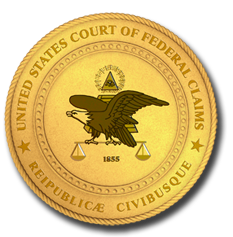 The U.S. Court of Federal Claims today issued a new set of local rules governing cases before the Court. The new rules are available at this link. Every practitioner before this Court should have a copy of the new rules. RJ Gaudet & Associates LLC represents Customs and Border Protection canine student instructors with wage and hour claims under the Fair Labor Standards Act in a case that is pending before this Court. Mr. Gaudet has defended depositions in San Diego and Washington D.C., drafted a brief, and conducted legal research on behalf of the Plaintiffs in this case against the U.S. Government.
The U.S. Court of Federal Claims today issued a new set of local rules governing cases before the Court. The new rules are available at this link. Every practitioner before this Court should have a copy of the new rules. RJ Gaudet & Associates LLC represents Customs and Border Protection canine student instructors with wage and hour claims under the Fair Labor Standards Act in a case that is pending before this Court. Mr. Gaudet has defended depositions in San Diego and Washington D.C., drafted a brief, and conducted legal research on behalf of the Plaintiffs in this case against the U.S. Government.
FREE CROSS-BORDER CONFERENCE AUGUST 6-7 FEATURES US-MEXICO LEADERSHIP
On August 6 and 7, 2015, El Paso and Juarez will host a bi-national conference called “A View From the Border” that is free to attend with presentations mostly in El Paso as UTEP (University of Texas El Paso) with one presentation in Juarez at the Cultural Center of the North. The agenda is available at this link.
Speakers will include the Commissioner of the U.S. Customs and Border Protection, Gil Kerlikowske; the Mexico Secretary of Energy, Pedro Joaquin Coldwell; the U.S. Secretary of the US Department of Commerce, Penny Pritzer; the Mexico Secretary of Economy, Ildefonso Guajardo Villarreal; Congressman Beto O’Rourke; and many others.
The topics that will be discussed include: “What’s Next For North America?”; “Moving People and Trade: What Does the Ideal U.S. – Mexico Border Look Like?”; “People Solving Problems: Where Civil Society Leads the Way”; “The Economic Future of North America: US – Mexico High Level Economic Dialogue”; and “Mexican Energy Reform and the Implications for the North American Economy.” This exciting conference will present the views of the most informed leaders in both countries and allow us to envision the future prospects for international trade, movement, and education across the border.
Mr. Gaudet and Mrs. Gaudet-Asmus of RJ Gaudet & Associates LLC plan to attend and are grateful to the staff members of Congressman O’Rourke, including but not limited to Mario Porras, for their hard work in organizing this conference. More information about the conference is available at this link and registration is open at this link.
Vaccine Compensation Fund Plays Invaluable Role in Compensating Victims Whom Lawyers Would Not Otherwise Represent
By Robert J. Gaudet, Jr.
After reviewing a provocative article posted in the “Stanford Lawyer” by Stanford professor Nora Freeman Engstrom (a former classmate of mine) about the infirmities of the $3.4 billion no-fault Vaccine Injury Compensation Fund that was set up to compensate victims so they don’t have to go to court with a lawsuit, I shared the article with a Seattle plaintiff’s lawyer, Lee Burdette, who has filed numerous cases with the Vaccine compensation fund. His experience is “quite different than the picture she paints,” he wrote.
Nora’s article concludes the Vaccine compensation fund takes too long (up to 5 years) to resolve cases instead of resolving them within the 240-day deadline and that it does not provide the guaranteed equal treatment to each claimant. Therefore, generalizing from this basis, she suggests that alternative compensation mechanisms might be less useful than traditional litigation in compensating victims in other fields, e.g., medical malpractice.
In Lee’s experience, however, the Vaccine compensation fund provides adequate compensation for victims who otherwise would not find lawyers to represent them in lawsuits in court. In addition, many claims are processed quickly, Lee says, and it is only a subset of contested off-the-Table claims and fee disputes that take longer. Lee responded to my email as follows: “if someone did a case by case analysis I think they would find” the following, as written in his own words (with very minimal editing by me):
“1. Many petitions are filed that are a) completely bogus; b) unsupported by proper documentation (medical records, expert reports, etc.); c) pro se. These cases take a long time to get through the system because there is no more lenient court in the world than the vaccine court about giving claimants more time to get it right – if I need another 30, 60 or even 90 days to do something, I simply call my opposing counsel, they agree and we file a stipulation.
2. Much of the time between case opening and closing is often devoted to fee and cost disputes. You would be shocked at the fee applications some of the major firms submit. It appears that the game for them is to ask for as much as they can and then litigate or negotiate. (By the way, we have never had a fee request challenged – they have all been entered by stipulation).
3. The cases that are brought as Table Injuries go quite quickly. The Vaccine compensation program was designed around the idea that the injuries that are scientifically accepted as being caused by vaccines should be compensated without much discussion. That principle is followed in my view. However, some claimants seek special damages because of the cap of $250K on general damages. That, of course, leads to the typical push back from defendants. Nevertheless, the awards seem pretty generous to me (with the exception of the general damages cap, which is a disgrace – Congress’ fault, not the program).
4. Cases that are not Table Injuries take much longer – and that is understandable. Claimants are always pushing to get compensation for everything that happens to them following a vaccination. Some of these claims may be spurious; others may be unsupportable by science. (I wonder how the hundreds or thousands of autism cases affected Nora’s averages). In my view, the Special Masters cultivate the principle of giving any tie to the claimant. It is a loose “preponderance of the evidence” standard.
Now, most of our cases are non-Table Injuries. Our experience is that the vast majority of them don’t exceed the 240-day guideline. We do have a beef with how long it takes to get the claimant’s money and our money (separate checks) after the case is concluded. It can be, often is, a few to several months.
All in all, I think the program is superior to litigating against drug companies, which I’ve done many time. Most of the people who go through the Vaccine Court would not even be able to get an attorney if the only recourse was to sue Merck or its ilk. Just too expensive for the types of claims that are typical.”
Nora’s article says she “studied nearly three decades of previously untapped material” but it’s not clear whether she interviewed any plaintiff’s lawyers, like Lee, or gathered anecdotal information. The latter approach served Prof. Deborah Hensler very well when she wrote a well-regarded book on class actions when she was employed at the Rand Institute. Given the differences between Nora’s apparently paper-based research and Lee’s real-world experience, it may be that this topic deserves a more in-depth look with a different methodology. It was good of Nora to dig through decades of materials, shine the light of inquiry, and raise this topic for discussion. She has nicely served the public and academia with her research.
The fund is a subject of criticism and debate. According to an episode on NPR, as overheard by Lee, the government intentionally does not publicize the fund because it is concerned that people might become more scared about using vaccines.
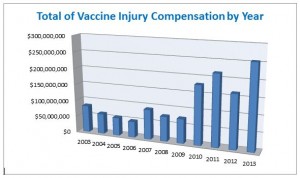
This chart shows the amount of money paid out to claimants each year by the Vaccine Injury Compensation Fund. Deciding these claims in one court in Washington, D.C. saves courts nationwide from having to process lawsuits around the country for damages.
A first! Stanford Alumni’s ‘Beyond the Farm’ comes to El Paso, TX
By Karin Gaudet-Asmus
On May 16, 2015 Stanford alumni from all over the world joined forces to make a difference in their local communities by volunteering for a day. This initiative, called ‘Beyond the Farm’, takes place every year in May. For May 16, 2015 Robert Gaudet and Karin Gaudet-Asmus helped organize this event in El Paso, Texas. A first for the city!

Together with Jose Luis Vilarreal, an officer of the alumni group in the region (El Paso Del Norte Stanford Alumni), we considered various local charities that could use the help of Stanford alumni for a day. As the charity of our choice, we picked Reynold’s Home, a shelter for women and children. Reynold’s Home celebrates its 25th anniversary this year.
Dr. and Mrs. William J. Reynold’s opened up their private home, a two story farmhouse built in 1926, to families in need. After the Reynolds passed away, their children (including current director of the home, Dorothy Truax) recognized what a great resource the home was for providing families in need with a place to stay while they put their lives back in order. Reynold’s Home is now publicly known as a shelter in El Paso and the community is welcome to help the shelter with their mission. One of their main projects at the moment is the building of a storage facility, for which they could use the help of a construction company and electrical expertise.
The families in the shelter typically have problems with domestic violence, immigration issues, poverty and other crisis situations. While at the Reynolds Home, individuals are expected to go to school and find employment. They acquire the skills to live productive lives when they leave. Families reside at the shelter for periods ranging from one month to two years. Dorothy personally takes time each week to talk to all of the ladies staying in the shelter to help them overcome obstacles on their way to independent living. The ladies are directed towards school programs, job counselors, life-skills classes, health programs, daycare and other resources in the community. Even when residents leave, Reynold’s Home provides them with occasional assistance in the form of food, payment of rent, deposits or utility bills. Reynold’s Home provides the women with a family for life!
A group of approximately 15 Stanford alumni, friends and family signed up for the El Paso Beyond the Farm initiative at the Reynold’s Home. There were multiple events scheduled for each part of the day, and activities included crafts, sports, and educational presentations, as well as a marketing and manual labor effort by the volunteers. Before the activities started in the morning, one girl – after observing the strangers in her house – asked me [Karin] whether we were there to entertain the kids. When the answer was affirmative, the girl shrieked and quickly ran upstairs – probably to inform her siblings and friends of the fun that was to be had.
In the morning, kids interested in crafts joined a competition led by volunteer Sandy V. and other members of Wise Latina International, as well as Stanford alum Andrea, to make the nicest painting of Reynold’s Home. The winners received coloring books as prizes. Stanford alum and Emmy award winner, Liz, together with volunteer Amanda, used the kids’ drawings to update promotional materials for Reynold’s Home. Some of the kids preferred to play sports and joined volunteers Gilbert and Mario for a game of soccer in the morning and football in the afternoon. In the afternoon, kids interested in crafts used q-tips to paint in pointillism style, as instructed by volunteer Glennis, with help from Isabella and others. The women got crafty, too: I gave instructions on how to make a print on canvas with gesso. Volunteers Monica and her daughter Cristina, who had her prom later that day, babysat some of the smallest children while the moms were crafting. Between craft sessions, Robert Gaudet gave a presentation to the women on wage and hour law and on how to expunge criminal records. Sandy C. of Wise Latina International helped translate the legal presentation and craft instructions, and helped out moms with the crafting activities. The handy men and women among us, such as volunteers Bryan and Terri, sanded and painted a greenhouse. The volunteers, staff, children and moms alike enjoyed the barbequed burgers and hot dogs that were prepared by Reynold’s Home’s own volunteers, Josh and Amanda, while listening to a presentation by Liz of Wise Latina International, a group that’s focused on empowering women. But perhaps the biggest hit of the day, for both the moms and the kids, was the Kung Fu lesson provided by Matt, a friend of Stanford alum Bryan and his wife Glennis, who takes Kung Fu classes.
